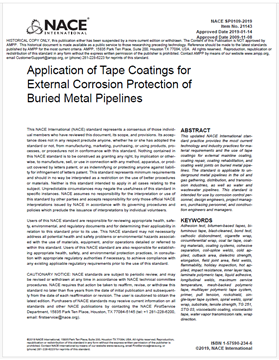Search
Products tagged with 'Standard Practices'
View as
Sort by
Display
per page
Moisture Testing and Inspecting for Concrete Floors to Receive Coatings
Product Number:
41216-991-SG
Publication Date:
2016
$20.00
NACE No. 10/SSPC-PA 6, Fiberglass-Reinforced Plastic (FRP) Linings Applied to Bottoms of Carbon Steel Aboveground Storage Tanks
Product Number:
21093-SG
Publication Date:
2002
$179.00
NACE No. 11/SSPC-PA 8-2003, Thin-Film Organic Linings Applied in New Carbon Steel Process Vessels
Product Number:
21099-SG
ISBN:
NACE No. 11
$109.00
NACE No. 4/SSPC-SP 7-2006-SG (Spanish), Limpieza Abrasiva Superficial
Product Number:
21180-SG
ISBN:
1-57590-102-1
Publication Date:
2006
$179.00
NACE Publication 43114-2014, "Nonvisible Contaminants on Railcar Surfaces"
Product Number:
24256-SG
Publication Date:
2014
$179.00
NACE RP0105-2005, Liquid-Epoxy Coatings for External Repair, Rehabilitation, and Weld Joints on Buried Steel Pipelines
Product Number:
21106-SG
Publication Date:
2005
$179.00
NACE RP0399-2004, Plant-Applied, External Coal Tar Enamel Pipe Coating Systems: Application, Performance, and Quality Control
Product Number:
21089-SG
Publication Date:
2004
$179.00
NACE RP0495-2003, Guidelines for Qualifying Personnel as Abrasive Blasters and Coating and Lining Applicators in the Rail Industries
Product Number:
21072-SG
Publication Date:
2003
$179.00
NACE RP0692-2003, Application of a Coating System to Exterior Surfaces of Steel Rail Cars
Product Number:
21058-SG
Publication Date:
2003
$179.00
NACE SP0107-2017, “Electrochemical Realkalization and Chloride Extraction for Reinforced Concrete”
Product Number:
21113-SG
ISBN:
1-57590-210-9
Publication Date:
2017
$179.00
NACE SP0109-2019, Application of Tape Coatings for External Corrosion Protection of Buried Metal Pipelines
Product Number:
21143-SG
Publication Date:
2019
$179.00
NACE SP0112-2017, Corrosion Management of Atmospherically Exposed Reinforced Concrete Structures
Product Number:
21166-SG
Publication Date:
2017
$179.00












